| Designation: | Bv 206 S |
 |
|---|---|---|
| Manufacturer: | BAE Systems Land Systems Hagglunds AB | |
| Product type: | Armoured Vehicles | |
| Name: | Tracked armoured personnel carrier |
The Bv 206 S was developed by the now BAE Systems Hägglunds and the Swedish Army Materiel Command (FMV) to meet the increased need for all-terrain mobility under armour protection.
The Bv 206 S is essentially an armoured version of the Bv 206 all-terrain vehicle, originally developed to meet the requirements of the Swedish Army and fully described in Jane's Military Vehicles and Logistics. By 2007, total sales of the Bv 206 had reached some 11,000 units and it was in service with more than 40 countries.
Four prototype Bv 206 S vehicles were completed from 1989 and the FMV subsequently ordered two vehicles, which were delivered late in 1989.
Following trials with preproduction vehicles configured as a troop carrier, armoured command post vehicle and ambulance, in early 1999 the German Army approved the Bv 206 S for service.
In March 2002, the contract for the procurement of 31 Bv 206 S ambulances was signed by the German procurement authorities and Rheinmetall Landsysteme GmbH of Kiel as the main contractor.
Total value of the first Bv 206 S contract to the now BAE Systems Hägglunds is SEK120 million with the German Army expected to eventually procure up to 200 vehicles of all types.
BAE Systems Hägglunds AB build the Bv 206 S and delivered these to Germany, to be fitted out and delivered to the German Army. The actual work is carried out at the company's Unterluess facilities, with deliveries running from 2002 through to 2004.
In addition to the troop carrier, armoured command post vehicle and ambulance (fitted out by Binz) a 120 mm mortar carrier will also be procured.
The first significant order for the Bv 206 S was placed by France. In September 1999 it was announced that the French DGA had awarded the now BAE Systems Hägglunds a contract worth SEK50 million (EUR3.8 million) for 12 Bv 206 S APCs for use by French Army units operating in Kosovo. These were delivered in February 2000.
Some of these French Bv 206 Ss are fitted with a turret armed with a .50 (12.7 mm) M2 machine gun. This turret is the same as that fitted to some Panhard VBL (4 × 4) scout cars of the French Army.
In June 2000, the company was awarded a contract by the Italian Ministry of Defence (MoD) for the supply of two Bv 206 S articulated all-terrain armoured personnel carriers for the Italian Army.
These were used for an extensive series of trials, which resulted in Italy placing two additional orders with the company late in 2003.
The first contract, worth EUR57 million was signed in October 2003 and covered the supply of 112 Bv 206 S vehicles.
This was followed late in November by a further order worth EUR24 million for the supply of 34 Bv 206 S and 12 unamoured standard Bv 206 vehicles.
Of these 12 standard Bv 206 vehicles, four were in troop carrier configuration and eight will be fitted to carry the Raytheon TOW ATGW system.
The total Italian Army requirement is for 189 Bv 206 S vehicles with the third batch of 43 vehicles expected to be ordered in the future. Deliveries for the first and second orders will run from October 2004 through to July 2009.
Italy also placed a contract worth EUR8 million in 2003 that covered the reconfiguration of 40 standard Bv 206 troop carriers into more specialised versions including four ambulances, eight TOW missile carriers and 28 command post vehicles. These were some of the 84 Bv 206 vehicles already operated by the Italian Army.
The Italian Army already operates 90 of the earlier Bv 206 unarmoured vehicles which share many common components with the more recent armoured Bv 206 S.
In September 2000, the Spanish Army placed its first order for 10 Bv 206 S vehicles with the total requirement being 50 units for operating in the Pyrennees.
In March 2001, the Swedish Defence Material Agency awarded a contract worth SEK70 million (GBP5 million) for the supply of 15 Bv 206 S armour protected all-terrain tracked carriers for the Swedish Army.
These Bv 206 S is earmarked for use by Sweden's rapid reaction force for international service which will form part of the European Union's joint force. The order for 15 Bv 206 S comprises three versions, personnel carrier, cargo carrier and ambulance. This is the first major order for Bv 206 S from Sweden.
In September 2001, Spain ordered its second batch of 10 Bv 206 S vehicles bringing to 20 the number of vehicles ordered, out of a total requirement for 50 units. Description
The chassis, drive train and steering system on the Swedish Army configuration are identical to the Bv 206, but the all-welded steel bodies and the cooling system are new. For other customers, new enhancement has been accomplished on sub-systems such as steering, brakes and track assemblies.
The basic Bv 206 S consists of two tracked units, which are linked together with a steering unit. The front unit has seats for the driver and three passengers and the rear unit has eight seats.
The track assemblies are attached to the central beam by two transversal leaf springs. Each track assembly is built up around a tubular bar, which carries the sprocket assembly, road wheels and idler.
In each track assembly there are four pairs of road wheels on trailing arms sprung by rubber tension springs. The idler at the rear with a tensioning device is also supported by a rubber spring. All four track assemblies of the vehicle are identical and interchangeable. The tracks are rubber with longitudinal textile cord and integral steel profile reinforcements.
Steering is accomplished by changing the direction between the front and rear unit by two hydraulic cylinders, servo-controlled from a conventional steering wheel. The hydraulic system is built with commercially available components and the steering system is designed to permit a large freedom of movement between the two bodies.
The diesel engine and transmission are mounted in the front unit. A shaft connects the gearbox with the drop-down gearbox. A disc brake is mounted in front of the drop-down gearbox inside the body. Cardan shafts transmit power to the final drives on the front end of both chassis.
The all-welded steel armour of the Bv 206 S provides the crew with protection against 7.62 mm ball ammunition at point blank range as well as shrapnel from artillery fire. All windows have the same protection level as the body. The front unit also has a circular roof hatch that opens to the rear. The rear unit has a large door in the rear that opens to the right and a roof hatch that opens to the right. This door has a single window in its upper part.
The Bv 206 S is fully amphibious, being propelled in the water by its tracks and has been designed to operate in temperatures from -46 to +49°C.
The Bv 206 S can be equipped with a ring mount for a 7.62 mm or .50 (12.7 mm) machine gun or a 40 mm grenade launcher.
The Bv 206 S is fully air-portable and can be transported inside a CH-47 or CH-53 helicopter. It can also be airdropped from fixed-wing aircraft. Variants
In addition to the basic armoured personnel carrier, other versions suggested by the manufacturer include mortar carrier, command post vehicle and recovery vehicle.
|
||||||||||||||||||
|
|||||||||||||||||||||||||||||||||||
All contracts...
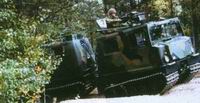 |
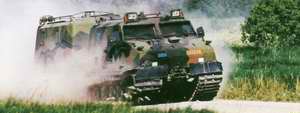 |
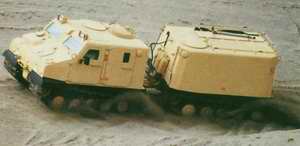 |
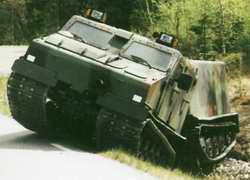 |
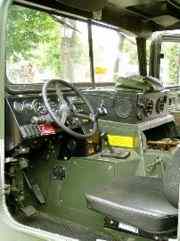 |



